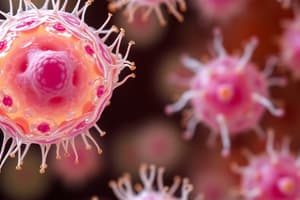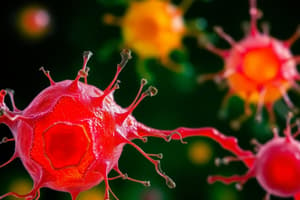Podcast
Questions and Answers
What is the primary function of ribosomes in a cell?
What is the primary function of ribosomes in a cell?
- Cell division
- Protein synthesis (correct)
- Genetic information storage
- Energy production
Which of the following statements about mitochondria is accurate?
Which of the following statements about mitochondria is accurate?
- They store nutrients for the cell.
- They generate ATP through cellular respiration. (correct)
- They are involved in photosynthesis.
- They contain genetic material.
What role do lysosomes play in a cell?
What role do lysosomes play in a cell?
- Photosynthesis
- Energy production
- Protein synthesis
- Breaking down waste materials (correct)
What are the basic building blocks of proteins?
What are the basic building blocks of proteins?
Which biological molecule is responsible for the storage and transmission of genetic information?
Which biological molecule is responsible for the storage and transmission of genetic information?
What is the main purpose of the Golgi apparatus in a cell?
What is the main purpose of the Golgi apparatus in a cell?
Which is true about prokaryotic cells?
Which is true about prokaryotic cells?
Which process converts light energy into chemical energy?
Which process converts light energy into chemical energy?
What is the primary difference between aerobic and anaerobic respiration?
What is the primary difference between aerobic and anaerobic respiration?
Which statement correctly describes the role of genes?
Which statement correctly describes the role of genes?
What occurs during meiosis?
What occurs during meiosis?
Which of the following best describes natural selection?
Which of the following best describes natural selection?
What is the primary purpose of homeostasis in the human body?
What is the primary purpose of homeostasis in the human body?
Which ecological concept describes the gradual changes in a community over time?
Which ecological concept describes the gradual changes in a community over time?
What is one of the main functions of the circulatory system?
What is one of the main functions of the circulatory system?
Which of the following factors can negatively impact biodiversity?
Which of the following factors can negatively impact biodiversity?
Flashcards
What is a cell?
What is a cell?
The basic structural and functional unit of all living organisms.
What are prokaryotic cells?
What are prokaryotic cells?
These cells lack a nucleus and membrane-bound organelles, found in bacteria.
What are eukaryotic cells?
What are eukaryotic cells?
These cells have a nucleus and various membrane-bound organelles, found in plants and animals.
What is the cell membrane?
What is the cell membrane?
Signup and view all the flashcards
What is the cytoplasm?
What is the cytoplasm?
Signup and view all the flashcards
What is the nucleus?
What is the nucleus?
Signup and view all the flashcards
What are mitochondria?
What are mitochondria?
Signup and view all the flashcards
What are ribosomes?
What are ribosomes?
Signup and view all the flashcards
What is aerobic respiration?
What is aerobic respiration?
Signup and view all the flashcards
What is anaerobic respiration (fermentation)?
What is anaerobic respiration (fermentation)?
Signup and view all the flashcards
What are genes?
What are genes?
Signup and view all the flashcards
What is DNA replication?
What is DNA replication?
Signup and view all the flashcards
What is gene expression?
What is gene expression?
Signup and view all the flashcards
What is an ecosystem?
What is an ecosystem?
Signup and view all the flashcards
What is natural selection?
What is natural selection?
Signup and view all the flashcards
What is homeostasis?
What is homeostasis?
Signup and view all the flashcards
Study Notes
Cell Structure and Function
- Cells are the basic units of life, exhibiting diverse structures and functions.
- Prokaryotic cells (e.g., bacteria) lack a nucleus and membrane-bound organelles.
- Eukaryotic cells (animal and plant cells) possess a nucleus and various organelles with specific roles.
- The cell membrane regulates the passage of substances into and out of the cell.
- The cytoplasm is the jelly-like substance where many chemical reactions occur within the cell.
- The nucleus contains the cell's genetic material (DNA), governing cellular activities.
- Mitochondria are sites of cellular respiration, producing ATP (energy).
- Ribosomes are responsible for protein synthesis.
- Endoplasmic reticulum (ER) participates in protein and lipid synthesis.
- Golgi apparatus modifies, sorts, and packages proteins and lipids.
- Lysosomes contain enzymes for breaking down waste materials.
- Vacuoles store water, nutrients, and waste products. Vacuoles play a role in turgor pressure in plant cells.
- Chloroplasts, found solely in plant cells, execute photosynthesis.
- Cell walls are rigid structures in plant cells, providing support and protection.
- The cytoskeleton gives the cell internal support and enables cell movement.
Biological Molecules
- Four primary biological molecule classes are vital for life: carbohydrates, lipids, proteins, and nucleic acids.
- Carbohydrates store energy (starch, glycogen) and provide structural support (cellulose).
- Lipids include fats for energy storage, phospholipids for cell membranes, and steroids for hormones.
- Proteins perform diverse functions—enzymes, transport, and structural components (collagen).
- Amino acids are the building blocks of proteins, connected by peptide bonds.
- Nucleic acids store and transmit genetic information (DNA, RNA).
- DNA carries the genetic code for protein synthesis.
- RNA participates in protein synthesis and other cellular processes.
- Molecular interactions and bonds give molecules their properties.
Biological Processes
- Metabolism encompasses all the chemical reactions in an organism.
- Enzymes catalyze metabolic reactions, lowering activation energy.
- Photosynthesis converts light energy into chemical energy (glucose).
- Respiration releases energy from glucose to ATP.
- Aerobic respiration (with oxygen) involves glycolysis, the Krebs cycle, and electron transport.
- Anaerobic respiration (fermentation) generates less ATP, producing lactic acid or ethanol.
- Water is a crucial solvent for biological processes, involved in numerous reactions.
- Cellular function is influenced by the concentration of substances inside and outside the cell.
Genetics
- Genes, segments of DNA, encode specific proteins.
- DNA replication ensures accurate copying of genetic information.
- Gene expression involves transcription (DNA to RNA) and translation (RNA to protein).
- Gene mutations can alter the genetic code, potentially affecting protein function.
- Chromosomes contain tightly-packed DNA.
- Cell division (mitosis and meiosis) facilitates growth, repair, and reproduction.
- Mitosis creates two identical diploid daughter cells.
- Meiosis generates four genetically distinct haploid daughter cells for sexual reproduction.
Ecology
- Ecosystems are intricate networks of organism-environment interactions.
- Organisms occupy specific niches defined by interactions like competition, predation, and symbiosis (mutualism, parasitism).
- Food webs display energy flow within ecosystems.
- Biomes are large-scale terrestrial ecosystems categorized by climate and vegetation.
- Populations exhibit growth patterns influenced by limiting factors.
- Succession describes gradual community change over time.
- Biodiversity represents the variety of life at various levels.
- Biodiversity is affected by habitat loss, climate change, and pollution.
- Nutrient cycles and energy flow are significant ecological concepts.
Evolution
- Evolution describes gradual changes in inherited traits across generations.
- Natural selection drives advantageous traits to become more prevalent.
- Adaptations are beneficial heritable traits enhancing survival and reproduction.
- Speciation forms new species from existing ones.
- Fossil records, comparative anatomy, and DNA analysis support the concept of evolution.
- Genetic variation within populations is vital for evolutionary changes.
Human Physiology
- Homeostasis maintains a stable internal body environment.
- The nervous system controls and coordinates body functions through stimuli and responses.
- The endocrine system regulates functions using hormones.
- The respiratory system facilitates oxygen and carbon dioxide exchange.
- The circulatory system transports oxygen, nutrients, and waste.
- The digestive system breaks down food and absorbs nutrients.
- The excretory system removes waste products.
- The immune system defends against pathogens.
- Body systems work together for overall health.
Studying That Suits You
Use AI to generate personalized quizzes and flashcards to suit your learning preferences.




